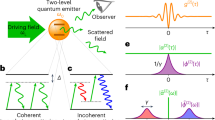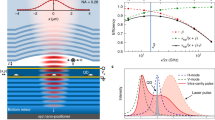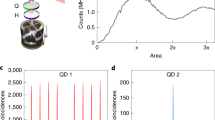Abstract
The excitation of individual two-level quantum systems using an electromagnetic field is an elementary tool of quantum optics, with widespread applications across quantum technologies. The efficient excitation of a single two-level system usually requires the driving field to be at the same frequency as the transition between the two quantum levels. However, in solid-state implementations, the scattered laser light can dominate over the single photons emitted by the two-level system, imposing a challenge for single-photon sources. Here, we propose a background-free method for the coherent excitation and control of a two-level quantum system using a phase-locked dichromatic electromagnetic field with no spectral overlap with the optical transition. We demonstrate this method experimentally by stimulating single-photon emission from a single quantum dot embedded in a micropillar, reaching single-photon purity of 0.988(1) and indistinguishability of 0.962(6). The phase-coherent nature of our two-colour excitation scheme is demonstrated by the dependence of the resonance fluorescence intensity on the relative phase between the two pulses. Our two-colour excitation method represents an additional and useful tool for the study of atom–photon interaction, and the generation of spectrally isolated indistinguishable single photons.
This is a preview of subscription content, access via your institution
Access options
Access Nature and 54 other Nature Portfolio journals
Get Nature+, our best-value online-access subscription
$29.99 / 30 days
cancel any time
Subscribe to this journal
Receive 12 print issues and online access
$209.00 per year
only $17.42 per issue
Buy this article
- Purchase on Springer Link
- Instant access to full article PDF
Prices may be subject to local taxes which are calculated during checkout





Similar content being viewed by others
Data availability
The data that support the plots within this paper and other findings of this study are available from the corresponding authors upon reasonable request.
References
Rabi, I. I., Millman, S. & Kusch, P. The molecular beam resonance method for measuring nuclear magnetic moments. The magnetic moments of 3Li6, 3Li7 and 9F19. Phys. Rev. 55, 526–535 (1939).
Ramsey, N. F. A molecular beam resonance method with separated oscillating fields. Phys. Rev. 78, 695–699 (1950).
Autler, S. H. & Townes, C. H. Stark effect in rapidly varying fields. Phys. Rev. 100, 703–722 (1955).
Mollow, B. R. Power spectrum of light scattered by two-level systems. Phys. Rev. 188, 1969–1975 (1969).
Bennett, C. H. & DiVincenzo, D. P. Quantum information and computation. Nature 404, 247–255 (2000).
Leibfried, D., Blatt, R., Monroe, C. & Wineland, D. Quantum dynamics of single trapped ions. Rev. Mod. Phys. 75, 281–324 (2003).
Bonadeo, N. H. et al. Coherent optical control of the quantum state of a single quantum dot. Science 282, 1473–1476 (1998).
Press, D., Ladd, T. D., Zhang, B. & Yamamoto, Y. Complete quantum control of a single quantum dot spin using ultrafast optical pulses. Nature 456, 218–221 (2008).
Lodahl, P., Mahmoodian, S. & Stobbe, S. Interfacing single photons and single quantum dots with photonic nanostructures. Rev. Mod. Phys. 87, 347–400 (2015).
Weber, J. R. et al. Quantum computing with defects. Proc. Natl Acad. Sci. USA 107, 8513–8518 (2010).
Clarke, J. & Wilhelm, F. K. Superconducting quantum bits. Nature 453, 1031–1042 (2008).
Zrenner, A. et al. Coherent properties of a two-level system based on a quantum-dot photodiode. Nature 418, 612–214 (2002).
Stievater, T. H. et al. Rabi oscillations of excitons in single quantum dots. Phys. Rev. Lett. 87, 133603 (2001).
Michler, P. et al. A quantum dot single-photon turnstile device. Science 290, 2282–2285 (2000).
Santori, C., Fattal, D., Vučković, J., Solomon, G. S. & Yamamoto, Y. Indistinguishable photons from a single-photon device. Nature 419, 594–597 (2002).
Muller, A. et al. Resonance fluorescence from a coherently driven semiconductor quantum dot in a cavity. Phys. Rev. Lett. 99, 187402 (2007).
Vamivakas, A. N., Zhao, Y., Lu, C.-Y. & Atature, M. Spin-resolved quantum-dot resonance fluorescence. Nat. Phys. 5, 198–202 (2009).
He, Y.-M. et al. On-demand semiconductor single-photon source with near-unity indistinguishability. Nat. Nanotechnol. 8, 213–217 (2013).
Buckley, S., Rivoire, K. & Vučković, J. Engineered quantum dot single-photon sources. Rep. Prog. Phys. 75, 126503 (2012).
Senellart, P., Solomon, G. & White, A. High-performance semiconductor quantum-dot single-photon sources. Nat. Nanotechnol. 12, 1026–1039 (2017).
Ding, X. et al. On-demand single photons with high extraction efficiency and near-unity indistinguishability from a resonantly driven quantum dot in a micropillar. Phys. Rev. Lett. 116, 020401 (2016).
Somaschi, N. et al. Near-optimal single-photon sources in the solid state. Nat. Photon. 10, 340–345 (2016).
Wang, H. et al. Near-transform-limited single photons from an efficient solid-state quantum emitter. Phys. Rev. Lett. 116, 213601 (2016).
Aaronson, S. & Arkhipov, A. The computational complexity of linear optics. In Proc. 43rd Annu. ACM Symp. Theory of Computing 333–342 (ACM, 2011).
Kok, P. et al. Linear optical quantum computing with photonic qubits. Rev. Mod. Phys. 79, 135–174 (2007).
Müller, M. et al. On-demand generation of indistinguishable polarization-entangled photon pairs. Nat. Photon. 8, 224–228 (2014).
Schweickert, L. et al. On-demand generation of background-free single photons from a solid-state source. Appl. Phys. Lett. 112, 093106 (2018).
Hanschke, L. et al. Quantum dot single-photon sources with ultra-low multi-photon probability. npj Quantum Inf. 4, 43 (2018).
Huber, T. et al. Measurement and modification of biexciton–exciton time correlations. Opt. Express 21, 9890–9898 (2013).
Wang, H. et al. On-demand semiconductor source of entangled photons which simultaneously has high fidelity, efficiency, and indistinguishability. Phys. Rev. Lett. 122, 113602 (2019).
Htoon, H. et al. Interplay of Rabi oscillations and quantum interference in semiconductor quantum dots. Phys. Rev. Lett. 88, 087401 (2002).
Grange, T. et al. Reducing phonon-induced decoherence in solid-state single-photon sources with cavity quantum electrodynamics. Phys. Rev. Lett. 118, 253602 (2017).
Iles-Smith, J. et al. Phonon scattering inhibits simultaneous near-unity efficiency and indistinguishability in semiconductor single-photon sources. Nat. Photon. 11, 521–526 (2017).
Glässl, M., Barth, A. M. & Axt, V. M. Proposed robust and high-fidelity preparation of excitons and biexcitons in semiconductor quantum dots making active use of phonons. Phys. Rev. Lett. 110, 147401 (2013).
Quilter, J. H. et al. Phonon-assisted population inversion of a single InGaAs/GaAs quantum dot by pulsed laser excitation. Phys. Rev. Lett. 114, 137401 (2015).
Förstner, J. et al. Phonon-assisted damping of Rabi oscillations in semiconductor quantum dots. Phys. Rev. Lett. 91, 127401 (2003).
Pan, J. W. et al. Multiphoton entanglement and interferometry. Rev. Mod. Phys. 84, 777–838 (2012).
Humphreys, P. C. Deterministic delivery of remote entanglement on a quantum network. Nature 558, 268–273 (2018).
Ates, S. et al. Post-selected indistinguishable photons from the resonance fluorescence of a single quantum dot in a microcavity. Phys. Rev. Lett. 103, 167402 (2009).
He, Y.-M. et al. Polarized indistinguishable single photons from a quantum dot in an elliptical micropillar. Preprint at https://arxiv.org/abs/1809.10992 (2018).
Acknowledgements
The National Natural Science Foundation of China, the Chinese Academy of Science, Anhui Initiative in Quantum Information Technologies, the Science and Technology Commission of Shanghai Municipality, the National Fundamental Research Program and the State of Bavaria supported this work. M.A. is supported by an ERC Consolidator Grant PHOENICS (no. 617985), and the EPSRC Quantum Technology Hub NQIT (EP/M013243/1). C.S. acknowledges support by the DFG within the project SCHN1376 5-1.
Author information
Authors and Affiliations
Contributions
C.-Y.L. and J.-W.P. conceived the idea and designed the experiment. C.S. and S.H. grew the quantum dot samples. Y.-M.H., H.W., C.W., X.D., J.Q., Z.-C.D., S.C., J.-P.L., R.-Z.L. and C.-Y.L. performed the experiment. C.W., M.-C.C., M.A. and C.-Y.L. performed theoretical modelling and analysed the experimental data. C.-Y.L. wrote the paper with input from all authors. C.-Y.L. and J.-W.P. supervised the whole project.
Corresponding authors
Ethics declarations
Competing interests
The authors declare no competing interests.
Additional information
Publisher’s note: Springer Nature remains neutral with regard to jurisdictional claims in published maps and institutional affiliations.
Supplementary information
Supplementary Information
Supplementary Information.
Rights and permissions
About this article
Cite this article
He, YM., Wang, H., Wang, C. et al. Coherently driving a single quantum two-level system with dichromatic laser pulses. Nat. Phys. 15, 941–946 (2019). https://doi.org/10.1038/s41567-019-0585-6
Received:
Accepted:
Published:
Issue Date:
DOI: https://doi.org/10.1038/s41567-019-0585-6
This article is cited by
-
Robust parallel laser driving of quantum dots for multiplexing of quantum light sources
Scientific Reports (2024)
-
Ultra-low loss quantum photonic circuits integrated with single quantum emitters
Nature Communications (2022)
-
Quantum Fredkin and Toffoli gates on a versatile programmable silicon photonic chip
npj Quantum Information (2022)
-
Optical tomography dynamics induced by qubit-resonator interaction under intrinsic decoherence
Scientific Reports (2022)
-
Tailoring solid-state single-photon sources with stimulated emissions
Nature Nanotechnology (2022)



